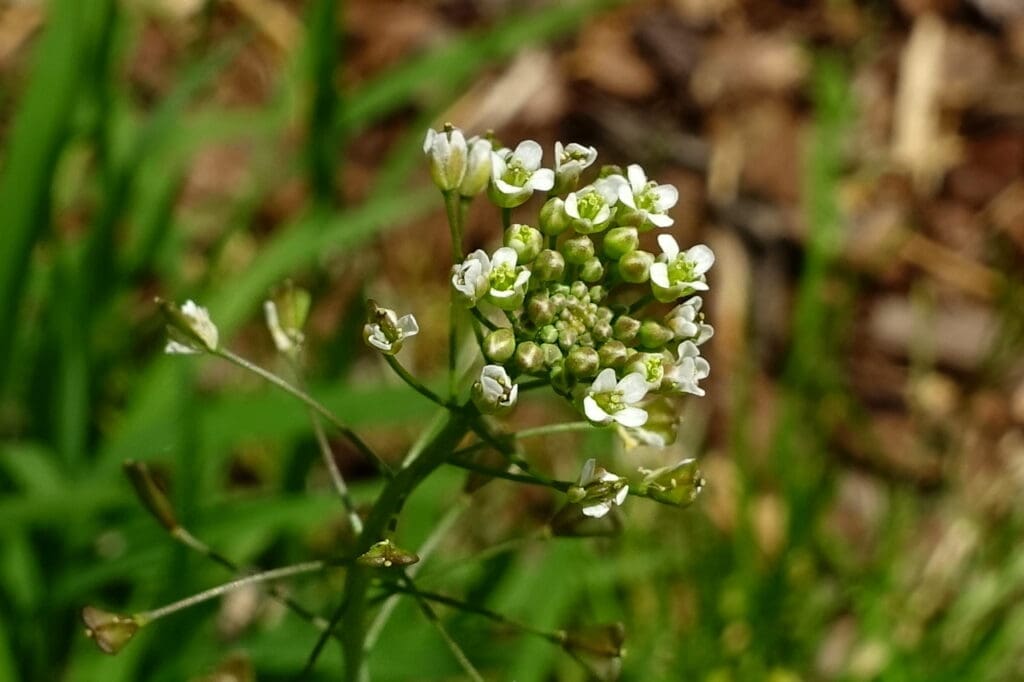
Bursa pastoris
Latin name: Bursa pastoris
Short name: Burs-p
Common name: Shepherd’s Purse | Mother’s Heart | Pickpocket | Caseweed | Capsella
Primary miasm: Psoric Secondary miasm(s): Sycotic
Kingdom: Plants
Family: Brassicaceae (Mustard family)
- Symptomatology
- Remedy Information
- Differentiation & Application
Bursa pastoris is a small annual plant in the mustard family, characterised by its triangular, purse-shaped seed pods resembling an old-fashioned shepherd’s leather purse. Widely distributed in temperate regions, it grows prolifically as a weed along roadsides, fields, and gardens. In herbal medicine, it is renowned for its haemostatic properties and its ability to influence uterine bleeding. In homeopathic form, it is prepared from the fresh flowering plant, potentised to avoid the toxic or crude effects while retaining the full medicinal action on circulation, bleeding tendencies, and the genito-urinary system.
Used in herbal medicine for centuries as a styptic, to control uterine haemorrhage, postpartum bleeding, nosebleeds, and haematuria. Employed as a mild diuretic and tonic. In some folk traditions, used to regulate menstrual flow and as a compress for wounds.
No extensive Hahnemannian proving exists; symptoms chiefly from toxicological reports, clinical observations (Clarke, Boericke), and empirical herbal usage confirmed in homeopathic practice.
- Uterus and female reproductive organs: Regulates and checks abnormal uterine bleeding.
- Kidneys and bladder: Haematuria, dysuria, and post-partum urinary troubles.
- Blood vessels and capillaries: Haemorrhage tendency, passive or active.
- Circulatory system: Venous congestion, varicosities, bleeding from nose and other mucous membranes.
- Rest, lying down after haemorrhage [Clarke].
- Local application of cold compresses to bleeding site.
- Open air during headaches.
- Movement and exertion during or after bleeding episodes.
- Suppressed menstruation suddenly returning in gushes.
- Straining to urinate or defecate.
- Post-partum exertion.
- Sabina – Uterine haemorrhage with clots, worse from least motion; often bright red mixed with dark.
- Trillium pendulum – Profuse gushing bright red haemorrhage with faintness.
- Erigeron – Bright red bleeding from uterus, bladder, or lungs, with aggravation from exertion.
- Crocus – Dark stringy blood, sensation of something alive in abdomen.
- Complementary: Trillium, Erigeron.
- Antidotes: Unknown in homeopathic literature.
- Follows well: China in anaemia from blood loss.
The essence of Bursa pastoris lies in its capacity to restore balance to a system weakened by chronic or acute passive haemorrhage, especially uterine. Its action is gentle yet persistent, regulating menstrual flow, stopping bleeding when excessive, and toning the atonic uterus. This is a remedy for the pale, worn, easily exhausted woman whose vitality seeps away in repeated losses.
- Consider in adolescent girls with delayed, irregular, or excessive menstruation.
- Very useful postpartum when the uterus fails to contract adequately.
- Bright red bleeding is more characteristic than dark, clotted blood.
- Can be used in herbal mother tincture form for acute haemorrhage while awaiting constitutional support.
Mind:
- Anxiety from haemorrhage.
- Fear of death from bleeding.
Head:
- Headache from loss of blood.
- Vertigo from anaemia.
Female:
- Metrorrhagia, bright red.
- Menorrhagia, passive.
- Postpartum haemorrhage, atonic uterus.
Urinary:
- Haematuria, bright red.
- Burning on urination with bleeding.
Generalities:
- Haemorrhage, passive.
- Weakness after loss of blood.
- Clarke J.H. – A Dictionary of Practical Materia Medica: Uterine haemorrhage, passive bleeding.
- Boericke W. – Pocket Manual of Homœopathic Materia Medica: Menorrhagia, metrorrhagia, haematuria.
- Hering C. – The Guiding Symptoms: Passive uterine haemorrhage, post-partum cases.
- Allen T.F. – Encyclopaedia of Pure Materia Medica: Clinical confirmations.
- Hughes R. – Manual of Pharmacodynamics: Herbal haemostatic properties applied homeopathically.
- Dewey W.A. – Practical Homœopathic Therapeutics: Grouping with other haemorrhage remedies.
- Nash E.B. – Leaders in Therapeutics: Chronic uterine bleeding.
- Farrington E.A. – Clinical Materia Medica: Differentiation from Sabina and Trillium.
- Tyler M.L. – Homœopathic Drug Pictures: Herbal background and cases.
- Boger C.M. – Synoptic Key: Haemorrhages with bright red blood.
